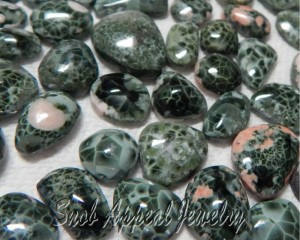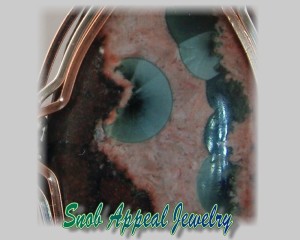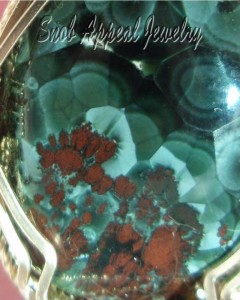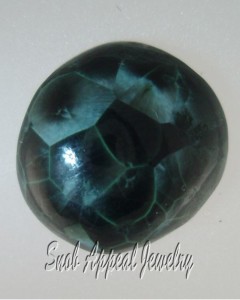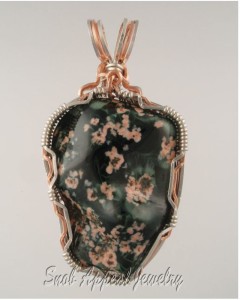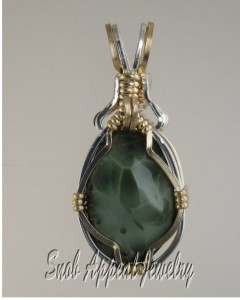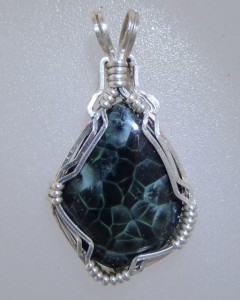Greenstone (Chlorastrolite) is the State Gem of Michigan. They are only found in the Keweenaw Peninsula and on Isle Royale (harvesting Greenstones in Isle Royale National Park is prohibited), with a few rolling up on North Shore beaches. These are known facts about Greenstone; but did you know that Greenstones can be many shades of green and contain many types of inclusions?
I thought, in this month’s blog, it might be fun to show you some of the uncounted associated minerals that can be found with Greenstone. I am mostly covering the more common inclusions, but I’ll show you some uncommon inclusions also. The Greenstones were all in my possession at one time, and are from my photo collection after years of Greenstone picking and collecting.
When I write about Greenstones colors, patterns, and inclusions I am speaking of an “average” stone. If I write something in my blog on the subject of Greenstones, someone may comment to the effect that what I wrote is not always the case. “Not always the case” is one of the laws of Greenstone, as well as many Rocks and minerals of Lake Superior.
Just when I think I’ve seen it all, there’s something different. Lake Superior Agates, Datolite, Prehnite, Thomsonite, and many other minerals from this area are famous for their surprises.
Greenstones from Isle Royale, in general (remember) are a lighter shade of green than those found in the Keweenaw. Isle Royale Greenstones most likely will be solidly patterned all the way through the stones, and require less skill than cutting a Keweenaw Greenstone that may have the chatoyant alligator pattern in a very thin layer, which is easily cut through. Cutting Keweenaw Greenstone is, many times, more like “erasing” the bad spots, rather than actually grinding. These Keweenaw stones may contain annoying little black dots that definitely do not enhance a Greenstone. I seldom see these dark inclusions in Isle Royale Stones. I have never been clear whether these spots are Chlorite or actually Chlorastrolite. There are other unwanted flaws that can occur in Greenstone; some I deal with, others, forget it. Only experience in Greenstone cutting can help you determine what you can deal with, and what you can’t. I could write a whole book on cutting Greenstones. Only by cutting thousands of these little buggers can you develop some expertise. You must, unfortunately, learn by your mistakes. Making mistakes was a lot easier to take years ago, when Greenstones were easier to find and far less expensive that they are today. I can never answer the question “How do you cut a Greenestone?”. The answer always boils down to the particular Greenstone you are cutting.
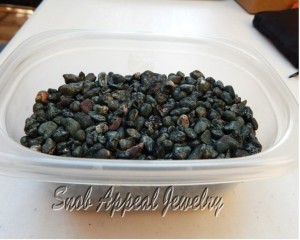
Tumbling these Greenstones from Islae Royale allows weeding. Notice the Thomsonite Inclusions on may little Greenstones.
OK, I got off track there a little bit. The point I wanted to make is not only are there good inclusions in Greenstone, but there are bad ones also.
Now lets look at some of the inclusions that really enhance a Greenstone. Coming from the Copper Country, an inclusion you might expect in Greenstone is Copper. Chlorastrolite filled the small voids in the amydaloidal basalt, as does most of the minerals found in the copper country. Rarely found together, the Copper and Greenstone are so beautiful together. On a rare occasion we may even find a Greenstone with Silver in it.
Datolite is another Copper Associated mineral that often in found in Greenstone, plain white Datolite is common, but other Datolite colors, especially pink, are also seen. Pink Datolite is always caused by micro-Copper in Datolite.
Thomsonite, my favorite Zeolite, is found in Greenstone. You can tell Thomsonite from Datolite by it’s silky, chatoyant, look. Datolite will be more porcelinious without a silky shine. Thomsonite in Greenstone can be pink or white.

Could this be Chlorastrolite replacement of Calcite? It sure looks like it to me. The pink is Prehnite.
Calcite is probably the most common inclusion, or you might say Greenstone is included in Calcite most of the time we see it together. When I see Greenstone in more clear Calcite, it seems to float as islands on top of the calcite. I love the three-dimensional look that is seen in Greenstone in Calcite. Commonly when Chlorastrolite is seen in Calcite, the Greenstone looks like dark, black-green lilypads instead of the more classic alligator-like pattern common to the gem. I like the lilypad look myself, but the stones do not fetch the price of a patterned Greenstone.
I have seen tiny Calcite crystals floating within the Greenstone also. It’s very nice when that happens, but most buyers of my Greenstone jewelry do not understand the rarity of this phenomenon.
On one occasion, I found bright red Cuprite on Greenstone. I never should have sold that one, as I’ve never seen another like it. It amazed the Director of the Seaman Mineral Museum.
Lastly I want to address the coloration and patterns of Greenstone. Greenstones can range from almost white to olive green to dark forest green. Sometimes Greenstones are so dark you’d swear they were black.
The patterns in Greenstones vary from large alligator to tiny alligator, to dark islands, to hardly any pattern at all. I’ve seen tiny donut circles, to shimmery flower-like chatoyant circles, to just a hint of pattern. When we find an obvious Greenstone without pattern we refer to it as a “Greenstone wanna-be”. Every round pebble on a spoil pole is green, so we pick them all up, perhaps tumble them overnight in 220, and look at the batch in the morning. The Greenstones will survive, but the Chlorite balls will not.
I’ve been cutting and polishing Greenstones for many years, and have enjoyed the differing colors and patterns in Greenstones; not all Greenstones are equal. My hope is by informing you of these details, you can come to appreciate one of the rarest gemstones on Earth. Greenstones continue to amaze and surprise me, but unfortunately the sources are diminishing.

This would be a very nice Greenstone except it contains unwanted inclusions of Chlorite. After a bit more work, this one became a real beauty.
Back in mining days, the miners never had a clue that their discarded rubble contained the lovely gem material that today is being crushed and hauled away for road fill. It’s exponentially harder today to find a nice Greenstone in the Keweenaw than it was a decade ago.
Explore our wide selection of Greenstone Cabochons, Greenstone Pendants and Greenstone Earrings as well as other jewelry from Keweenaw Minerals.










